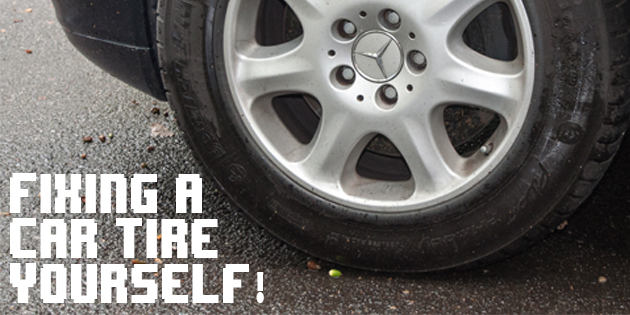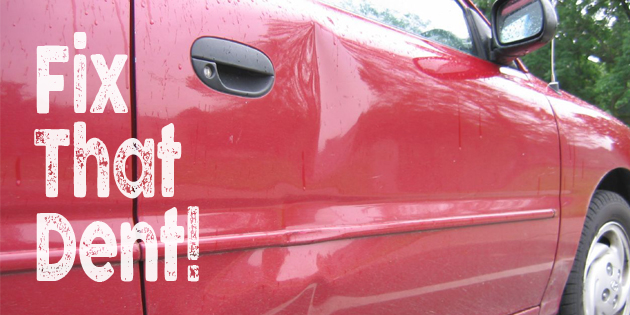Suffering flat tires is one of the great inconveniences of driving, but you don’t have to be stranded for hours when it happens to you.
Nor do you have to call for a tow truck or roadside assistance- there are ways to fix a flat tire yourself.
However, the better option is always to fit the spare tire, but if your spare is flat as well (it happens all too often), here is how to repair a flat tire if you ever have to.
Time required to fix a flat tire:
Time required is about 20 minutes to remove, repair, and replace the wheel on the car.
How difficult is it to fix a flat tire?
Fixing a flat tire is relatively easy, and any reasonably fit and healthy person should be able to repair a flat tire if they can remove a wheel form a car.
Special precautions needed when fixing a flat tire:
- Only punctures that occur on the tread of the tire can be repaired safely. Holes, cuts, and other damage on the sidewalls are NOT repairable, and tires with perforated or damaged sidewalls must be discarded.
- Before jacking up a vehicle to remove a flat tire, be sure to engage the parking brake, or to chock the wheels to prevent the vehicle rolling off the jack.
- Always support the vehicle with jack stands when you jack up vehicle for any reason. If you have to fix a flat tire at the road side, and no jack stands are available, try to locate the puncture without jacking up the vehicle. Only jack up the vehicle to remove the wheel if it proves impossible to repair the puncture with the wheel on the vehicle.
Tools/equipment required to fix a flat tire:
- Can of tire sealant (Optional, but available from all auto parts stores.)
- Tire repair kit. (Available from all auto parts stores)
- Air compressor.
- Tire pressure gauge.
- Lug wrench.
- Pair of pliers to remove foreign objects from the tire.
NOTE: Tire repair kits should contain a rasp tool to roughen the inside surface of the puncture, a tool to insert the plug, and a can of cement to stick the plug into the tire. Bear in mind though that all DIY tire repairs are only a temporary solution, and all damaged tires must be inspected professionally at the first opportunity to ensure that the repaired tire is safe to use.
Video: How To Fix A Flat Tire
Step 1- Finding the leak.
Inspect the tire to determine the amount of damage. If the tire is torn, cut, or severely damaged on the sidewalls, the better option is to replace the tire.
TIP: If the tire is not severely damaged, you may want to inject a can of tire sealant into the tire to seal the leak- provided of course you have a can of sealant available. Here is how:
- If the foreign object is accessible, use a pair of pliers to pull it out.
- Shake the can to mix the contents.
- Remove the valve cap from the tire valve, and screw the fitting on the end of the hose on the can onto the valve. Make sure it is screwed on fully to prevent sealant leaking past the connection.
- Hold the can upside down, and depress the valve on top of the can to inject the sealant into the tire. Allow all the contents of the can to enter the tire- you will see the flow of sealant stop through the transparent hose when the can is empty.
- Remove the hose from the tire valve, replace the valve cap, and drive off immediately to allow the sealant to spread out on the inside wall of the tire. The sealant will from a plug into the site of the leak, but the tire needs to rotate for this to happen.
NOTE: While tire sealants are a great way to get you out of a tight spot, they do not inflate tires fully, and the repair can never be regarded as reliable. This type of repair is a stop-gap measure at best, and the tire must be inspected and repaired professionally at the first opportunity that presents itself. At the very least, the tire must be inflated to the correct pressure as soon as possible.
Step 2- Remove the wheel from the car.
If the puncture was caused by a nail, screw, or similar object, and the puncture is on the tread, jack up the car, support it with jack stands, and remove the wheel.
TIP: If no jack stands are available, and the spare wheel is unusable, place the flat spare wheel under the car. This will prevent damage to the car should the worst happen and it falls off the jack.
Step 3- Remove the foreign object.
Use a pair of pliers to extract the object, but mark the location of the puncture. If the object is not visible and the tire is flat, inflate it, and dribble water over the entire tread circumference to locate the leak. The leak will cause bubbles to form- mark the location of the puncture with chalk or similar so you’ll find it again.
Step 4- Prepare the tire for repair.
Once you are certain you have located the leak, use the rasp tool in the tire repair kit to roughen up and clean the inside of the perforation. Just push the tool in to the hole, but be sure to follow the path of the puncture to avoid adding to the damage. Push and pull the rasp tool through the tread a few times to ensure that the inside surface of the perforation is roughened sufficiently for the cement to adhere properly.
Step 5- Insert the plug.
Thread a plug though the insertion tool, but make sure the plug is centred in the tool. Unequal lengths on either side of the tool can cause the plug to slip out of the tool when you insert the plug into the tire. Dip the plug and the end of the tool into the can of cement, and push the tool and the plug into the puncture until about an inch or so of the plug ends protrude above the tire tread surface.
NOTE: Be aware that it might require some effort to push the plug into the puncture, but resist the temptation to twist and turn the tool to make things easier. This could break the tool, or cause the plug to leak.
With the plug inserted into the puncture, wait about ten seconds or so before pulling out the tool in one swift movement, to cut through the plug without pulling the plug out of the tire again.
NOTE: The cement will stick the plug to the inside of the puncture, but if you extract the tool to soon, you will merely pull the plug out again. If you allow a few seconds for the cement to stick, you will cut through the plug easily, without disturbing the bond between the plug and the tire.
 Step 6- Check the repair for leaks.
Step 6- Check the repair for leaks.
You should now have two ends of the plug sticking out of the puncture, so wait about sixty seconds or so for the cement to cure, inflate the tire, and dribble water of the site of the repair to check for leaks. No bubbles mean no leaks, so use a sharp knife to cut the ends of the plug flush with the tire surface.
NOTE: This type of repair is not always successful, so if it the repair is still leaking, take careful note of the position of the leak and insert another plug EXACTLY on the site of the leak. However, if two plugs do not resolve the issue, do NOT insert a third. Such a tire may be leaking through the reinforcing plies beneath the tread, so have the tire inspected professionally since it may not be safe to use- even if the leak is repaired from inside the tire.
Step 7- Replace the wheel.
If you are certain that the repair is airtight, inflate the tire to the recommended pressure, and place it back on the vehicle. Tighten all lug nuts to the recommended torque, and use a criss-cross pattern to ensure even tightening.
Lower the car to the ground, and you are done.
Enjoy this article?
If so, I’d appreciate if you’d share it on social media!





No Comments